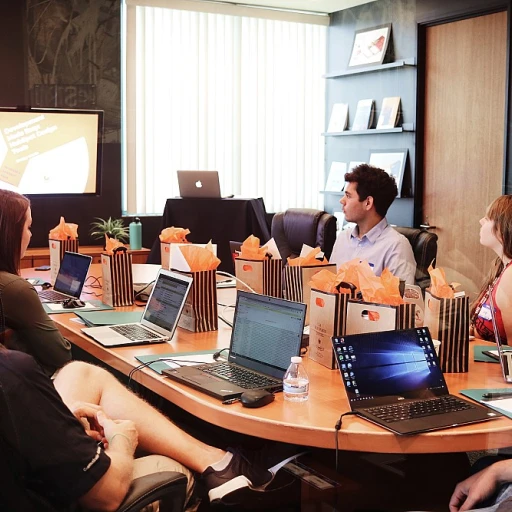
Understanding the Importance of Succession Planning
The Essence of Forward Planning
In the ever-evolving business landscape, effective succession planning has emerged as a fundamental organizational strategy. It’s not merely about replacing a leader who steps down; it’s about ensuring that the organization can maintain its stride when such changes occur. This foresight secures the long-term health and growth potential of a business.
Planning involves more than identifying potential leaders. It requires a comprehensive understanding of key roles and the critical skills necessary for these roles. This knowledge helps in crafting development programs that align with the company's future needs and strategic goals.
Leadership Development as a Pillar
Leadership development is at the core of succession planning, ensuring that future leaders are well-prepared to take on more responsibilities. It is about nurturing talent through a focused planning process that identifies high-potential employees and offers them the resources needed for growth. Programs like mentoring and coaching often form the backbone of these initiatives.
Aligning with Business Goals
Planning succession effectively aligns with broader business objectives. It involves critical reflection on business goals and how they translate into specific leadership roles and responsibilities. By having a well-structured succession plan, organizations ensure that they continue to meet market demands while fostering internal talent development.
For businesses venturing into leadership development, staying informed about industry trends and adopting best practices can offer a significant advantage, streamlining the process of identifying and nurturing potential successors.
Succession plans are not one-size-fits-all solutions but should be tailored to meet the unique challenges of your organization and its future aspirations.
Identifying Key Roles and Skills
Identifying Essential Responsibilities and Expertise
In the realm of succession planning, the identification of key roles and inherent skills is paramount. Organizations often overlook the significance of recognizing the critical roles that sustain their operational ecosystem. Without a precise understanding of these roles, it is challenging to construct an effective development programme or identify high potential leaders for future advancement.
A meticulous planning process involves a collaborative approach, where board members and senior leaders jointly review the current organizational structure. This partnership ensures that they can pinpoint roles pivotal to the organization's success. Leadership development inherently focuses on nurturing individuals with an aptitude for strategic decision-making, innovation, and adaptability—traits crucial for effective succession.
Mapping Out the Organizational Landscape
When defining these roles, consider the ongoing development needs and the expected evolution of the business environment. The skills required for a CEO in a family business might differ significantly from those in a tech startup. Hence, it's essential to tailor your plan according to your unique business context.
Beyond identifying roles, assessing current workforce abilities provides insight into talent management needs. This is not just about recognizing the current talent pool but also understanding potential knowledge gaps. By exploring pathways beyond traditional college education, organizations can broaden their horizons, embracing diverse skill sets that are often overlooked. These methods promote a holistic view of business development, preparing it for imminent leadership challenges.
In conclusion, systematically identifying and evaluating critical roles is a vital component in the succession planning process. By forecasting future leadership requirements and aligning them with organizational goals, businesses can ensure agile adaptation to evolving market dynamics, securing long-term sustainability and growth.
Developing a Reskilling Framework
Crafting a Comprehensive Reskilling Blueprint
A robust reskilling framework forms the backbone of any effective succession planning initiative. As businesses anticipate future needs, preparing potential leaders through targeted development programs is paramount. Leaders and HR professionals must work collaboratively to establish a clear plan that aligns organizational goals with the development needs of potential successors. One of the best practices in this process is the identification of critical skills and competencies for future leaders. Organizations should conduct a detailed analysis of the skills required for key roles, ensuring that potential successors are equipped with both technical expertise and strategic thinking abilities.- Focus on High-Potential Employees: Evaluate which individuals in the organization demonstrate the potential to rise to leadership positions. High-potential employees are typically those who showcase agility, innovation, and the drive to take on more responsibility.
- Structured Development Programs: Implementing structured programs tailored to enhance specific skills can significantly boost the talent pool's readiness for leadership roles. Development programs should encompass both theoretical learning and practical experiences.
- Continuous Feedback and Assessment: A dynamic reskilling framework integrates regular feedback sessions and performance assessments. This approach ensures that aspiring leaders grasp the developmental milestones they need to achieve.
Integrating Technology in Reskilling Initiatives
Leveraging Technology for Enhanced Reskilling
In today's rapidly evolving business landscape, integrating technology into reskilling initiatives is not just an option but a necessity. As organizations strive to ensure effective succession planning, leveraging technological tools can significantly enhance the reskilling process, ensuring that potential leaders are well-prepared for critical roles.
Technology offers a multitude of platforms and tools that can streamline the reskilling framework. From online learning platforms to virtual reality simulations, these tools provide flexible and scalable solutions for leadership development. They allow organizations to tailor training programs to meet the specific needs of their talent pool, ensuring that each potential successor is equipped with the necessary skills for their future roles.
Utilizing Data Analytics for Informed Decision-Making
Data analytics plays a pivotal role in the planning process by providing insights into the effectiveness of reskilling programs. By analyzing performance metrics and feedback, organizations can identify gaps in their development programs and make informed decisions to enhance their succession plans. This data-driven approach ensures that the planning succession is aligned with the long-term goals of the business.
Moreover, analytics can help in identifying high-potential individuals who may not have been considered for leadership roles. By assessing various performance indicators, organizations can uncover hidden talent and nurture these individuals for future leadership positions.
Embracing Digital Learning Platforms
Digital learning platforms are at the forefront of reskilling initiatives. These platforms offer a range of courses and training modules that can be accessed anytime, anywhere, making it easier for employees to upskill at their own pace. This flexibility is crucial for family businesses and organizations with a diverse workforce spread across different locations.
Furthermore, digital platforms often incorporate interactive elements such as quizzes and gamified learning experiences, which can enhance engagement and retention. By integrating these best practices into their reskilling strategy, organizations can ensure that their potential leaders are not only acquiring new skills but are also motivated and engaged in the learning process.
Ensuring Continuous Improvement
Technology also facilitates continuous improvement in reskilling initiatives. With regular updates and new content, digital platforms ensure that the training material remains relevant and aligned with the latest industry trends. This adaptability is crucial for maintaining a competitive edge and ensuring that the organization is prepared for future challenges.
In conclusion, integrating technology into reskilling initiatives is a critical component of effective succession planning. By leveraging digital tools and data analytics, organizations can enhance their talent management strategies, ensuring that they are well-equipped to develop future leaders and secure their long-term success.
Measuring the Success of Reskilling Programs
Evaluating Reskilling Programs for Effective Succession
To ensure the success of reskilling efforts within your succession plan, it is critical to establish solid evaluation metrics. Measuring the effectiveness of reskilling initiatives is a cornerstone that supports long-term planning and continuous improvement in talent management.
One of the main methods to measure success is by determining whether desired outcomes align with initial succession planning goals. Consider how well the program is preparing potential leaders for future roles. As an organization, reflect on whether the reskilling has adequately addressed the development of key skills needed in critical roles.
- Feedback Mechanisms: Implement regular feedback loops among participants, trainers, and program overseers. This can guide the direction of future adjustments in the reskilling framework.
- Performance Assessments: Reviewing the performance of participants before and after training helps demonstrate skill growth and readiness for leadership roles.
- Engagement Levels: Low engagement might signal the need for changes in the way development programs are conducted. High engagement often correlates with successful skill acquisition.
- Retention Rates: Monitoring whether potential leaders remain within the organization following reskilling provides insight into the program's impact on talent retention strategies.
- Adaptability: Evaluate how quickly and efficiently talent can transition into new roles within the business. Rapid adaptability is often a measure of effective succession planning.
Integrating these success metrics fosters an organization culture focused on continuous development. It empowers both the current leadership and potential successors to align with the organization’s strategic vision, ensuring that future leaders are well-equipped to handle the decision-making and leadership challenges that come with critical roles.













